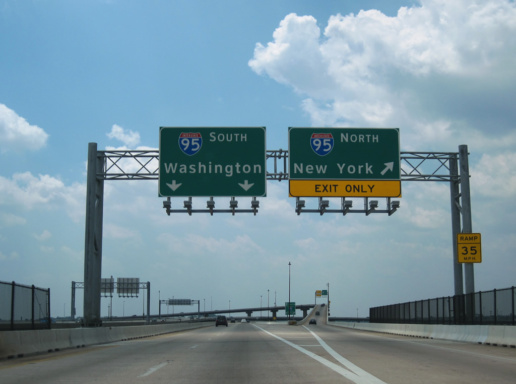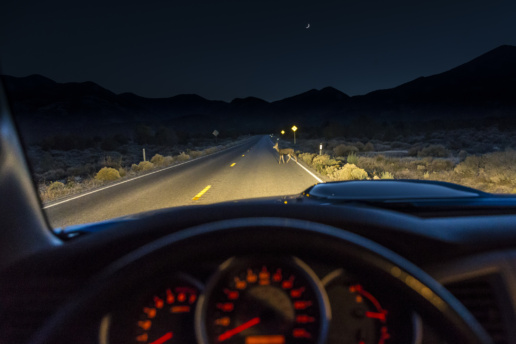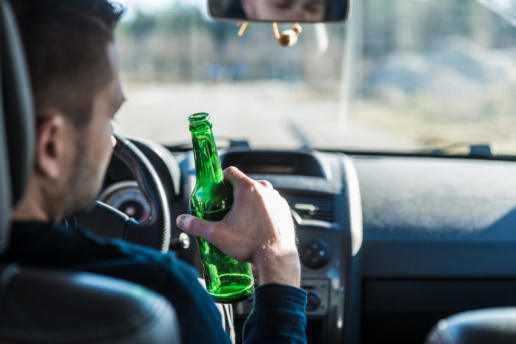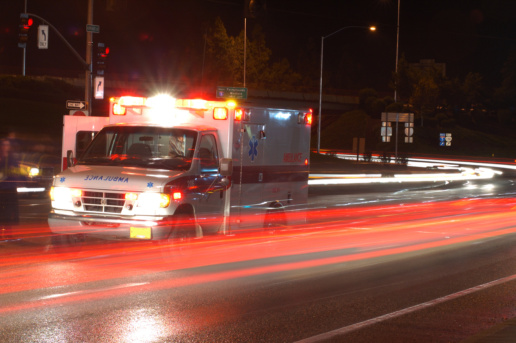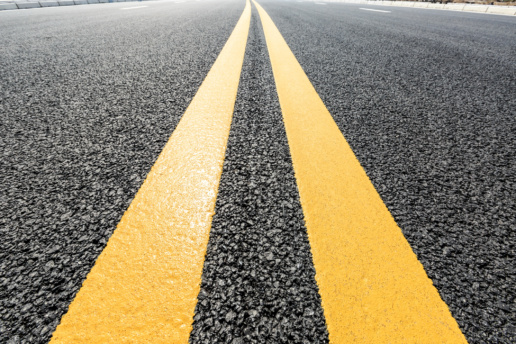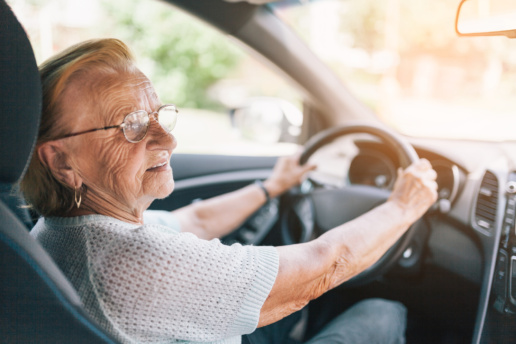Dear speedster, listen to me
A recent column in the Baltimore Sun grabbed my attention. Paula Beres, a mother and grandmother and a retired librarian, wrote about the people who use the highway -- in her case I-95 -- as a speedway - like, 'I am going to weave in and out of traffic as fast as I can and maybe I'll even race somebody who's game.'
This isn't something that's just happening on I-95. Hell no. It's everywhere. And, honestly, it fits right in with how people in our society don't seem to care about anyone but themselves.
Says Paula (in a sarcastic tone that I so appreciate):
"You might be wondering why I am traveling on I-95, selfishly trying to share the road with you while you have your “fun” playing the dangerous and deadly game of “Indy 500” with the lives of drivers around you. You leave the fast lane, move to my right lane in one fell swoop, and then weave back over to the fast lane so you can once again be “the first and the fastest.” Sometimes I see you and a buddy racing each other. By the way, you might think you “got” the lane switch down but sometimes you don’t. I’ve slammed on the brakes often these past two years. You are not as good as you think you are."
During the early days of the pandemic, the roads were largely abandoned. Is that what gave rise to these lawless speed demons? And now that traffic seems back to normal, they just have kept it up?
Paula goes on to say:
"I am begging you to learn a little bit about me before your next trip. I live in Baltimore, have three children, and I am also a grandmother to two beautiful little boys. Becoming a mother and grandmother has brought me so much joy — I cannot even begin to explain the feeling. One of my grandsons lives in Baltimore and the other lives in Alexandria. I travel I-95 once a week to visit and spend the night.
"In the back seat of my car is a cooler. Inside the cooler is a 9 by 13-inch pan of lasagna, cooked breakfast sausage, a dozen eggs, a bunch of bananas, a gallon of whole milk and a container of blackberries — all my grandson’s favorite foods, and foods they can’t keep enough of in the house.
"My suitcase is full of warm clothes this time of year because we try to take a walk together every day. Sometimes he sits in his wagon; other times in the stroller, and now that he started to walk, sometimes I just hold his tiny little hand."
I think that's what gets lost here. The people you drive with on the roadways all have lives, families, loved ones. They are breadwinners and people count on them. But because you don't know them, and don't take the time to think about this, you play highway roulette with unwilling participants.
Paula concludes with this:
"So there I am on I-95, driving the speed limit in one of the right hand lanes. I am a good driver, keeping my distance from the car in front of me and looking for problem drivers like you on the road. I don’t look at my phone. I don’t do anything to distract me from getting from Baltimore to Alexandria and back again safely. Yet, there you are, on every trip.
I don’t know how to stop you, but I am now begging you: Please slow down. Please put your blinker on. Please stop taking chances with my life. I don’t want to die. I have too much to live for."
Don't we all, Paula, don't we all.
Hiding Behind Those (Tinted) Windows
Tinted car windows, especially the completely dark ones, drive me crazy.
In my experience on the roads, it has given the driver of that car license to do really stupid and careless things on the road and no one can see who the culprit is.
Drivers already have a decent level of anonymity. Behave badly? Who cares? I’m never going to see these people again! I can do whatever I want! Drive down the emergency lane? Sure! Cut that guy off? If it gets me there faster….

Add tinted windows to the mix and, well, anonymity is guaranteed!
I mean, if you cut me off, I want to at least be able to give you a dirty scowl and know that you saw it!
Yes, I know that tinted windows in some states (Florida, for example) are perhaps a necessity. And, some people – famous ones – probably think they need them too.
Laws about how dark your tinted windows can vary by state. AAA’s Digest of Motor Laws provides a handy list of each state’s law.
New Hampshire, New Jersey and Vermont are the only three states that don’t allow window tinting. Other than that, it varies wildly from state to state.
According to Rayno Window Film, “Most states [limit] window tinting for safety and security purposes. Tinting limits the amount of light that enters the car but can make it hard to view the street. Limited vision leads to an increased number of accidents on the road. The other reason why tinting may be illegal is for public safety when it comes to the police and other federal agencies. Extremely dark tint can be obstructive to investigations, and dangerous during traffic stops and other incidents.”
All excellent points.
Rayno explains: “…Restrictions on the amount of visible light being transmitted into a car are defined and measured in percentages. These different percentages are the minimum amount of light that should be getting through the glass. The higher percentage means the tint is lighter. Lower tint percentage means the tint is darker. The legal percentage varies from state to state and also for the different windows of the car.”
Garage Chief provides a super handy look at the various tint levels.
VLT%: visible light transmission – the measurement used to assess automotive window tints. The percent of visible light that gets through either the film (film VLT%) or window plus film net VLT%. The lower the VLT%, the darker the tint.
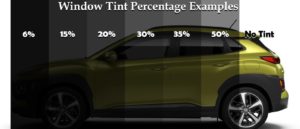
Now, is the highway patrol policing cars who violate the window tinting laws?

Yeah, no.
Resources:
AAA Digest of Motor Laws: Glass/Window Tinting
Rayno Window Film: Window Tint Percentage Laws In The US By State
Quit Riding Your Brakes
Do people who ride their brakes drive you as crazy as they do me? Probably not.
But that’s why I write the blog and you don’t.
I fantasize about being able to 'talk' to those drivers (and many others) and ask them why they do it.

Not only do other drivers not know what the heck you are doing when you ride your brakes, but it’s terrible for your car.
This completely unrelated non-driving blog says it best:
“We’re all familiar with the highway driving experience of being behind a person who is continually braking for no apparent reason. This is especially problematic if you’re in the left-hand lane. You’re zipping along at the posted speed limit and suddenly the brake lights of the car in front go on. You have to immediately react and hit your brakes. If this happens more than a couple of times, you look for the first opportunity to pass this unskilled driver. The person riding their brakes may thoughtlessly cause a serious traffic problem or worse.”
Let’s start with the practical downside of riding your breaks.
According to Car Talk, “when you're riding your brakes for a long period of time, all that friction turns into heat, which can overheat your brakes and cause them to fail.
“What actually happens is that the brakes get red-hot, and that heats up the brake fluid. Once the brake fluid boils, it's no longer able to transmit hydraulic pressure, and you can't stop the car. That kind of constant heat also increases the likelihood that your brake discs will warp and need to be replaced.”
So...bad.
But, what I’m specifically concerned about is how riding your brakes impacts the drivers around you.
Are you slowing down? Are you braking for a reason?
So, I go around you and as I am passing, I look over, and you’re just tooling along oblivious to the fact that you have one foot on the brake and one foot on the gas.
Did you not take Driver’s Ed?
“Any driving school instructor worth his or her clipboard will tell you that riding the brake – putting your foot on the brake pedal however lightly when you have no intention of slowing down or stopping – is a terrible driving habit.
“Not only will it wear your brake pads out quicker than under normal driving conditions, it will create uncertainty to the drivers behind you who see your red rear brake lights on but aren’t entirely sure of your intentions.”

Drive with one foot – the right foot. Move it back and forth between the gas pedal and the accelerator pedal as necessary.
Please. Thank you.
Resources:
NAPA Online: Why Riding Your Brakes is a Bad Idea
Vancouver Sun: When Riding the Brake is a Good Thing
CarTalk.com: Lower Gear vs. Riding Brakes. What's Best?
Avoid Tunnel Vision When Tunnel Driving
“Tunnel structures offer significant economic, social, and environmental advantages over the other more commonly employed highway structure alternatives…”
So why would I be required to write about tunnels?

It’s pretty straightforward [pun intended, get it?].
I mean, yes, it is an 'enclosed road environment', but…
There are no cars merging in.
Often, you can’t change lanes cause there’s a double white line [and we all know what that means, right?].
You’re not subject to the elements in a tunnel. No pouring rain, no driving snow, hail or other forms of precipitation.
Once inside, all you have to do is, well, drive.
So, when the speed limit is 55 mph in said tunnel, why, do some drivers feel compelled to go 40 mph? Or 45 mph? Or any number under the speed limit?
This. Is. Not. Hard.
You barely need to move your steering wheel. And turn your lights on if they don’t come on automatically. And take your sunglasses off. Duh.
Sure, you should be as careful in a tunnel as you are on the regular old highway.
The U.S. Department of Transportation Federal Highway Administration has put together this super useful ‘Tunnel Insider Tips’ to help you out if you are confused.
Pay attention, keep a safe distance, don’t do dumb things.
Other than that, PLEASE, just GO!
Note: If you suffer from claustrophobia, you should maybe avoid taking routes that require you to go through a tunnel.
Resources
U.S. Department of Transportation – Federal Highway Administration
Road Tunnel Safety
Tunnels: https://www.fhwa.dot.gov/bridge/tunnel/
Don’t Hit the Dang Deer
You know that old saying, “deer in the headlights?”

I don’t know about you, but I live in an area where there is a TON of deer. And, this is the time of year where you see them out and about a lot ‘cause their breeding season is in full swing.
You also see a lot of dead ones, hit by cars, sadly laying on the side of the road.
Horrible. Sends a chill down my spine every single time.
According to the Washington Department of Fish and Wildlife, “There are more deer-vehicle collisions as it gets dark earlier and as deer start to move a little more differently than normal during mating season.
“‘That makes deer a lot less cautious,’ said Staci Lehman. ‘They’ve got one thing on their mind, and they’re not looking out for cars and things like that.’
“State wildlife officials are asking that you slow down, don’t drive distracted, use your high beams when you can, and brake a little longer if you see just one deer, since often more deer will follow.
“‘Just because one deer runs across and you think, ‘Wow, I missed that.’ It’s a good idea to either slow down and stop and wait to see if more will pass,’ Lehman said.”
If you are driving on a less traveled roadway, be hyper-aware of them running out in front of you. In addition to not killing the deer, it is also a bonus to not wreck your car.
According to Jen Stockburger of Consumer Reports, “Deer are most active at dawn and between 6 p.m. and 9 p.m., so use your high beams.”
Consumer Reports lists these tips to avoid hitting a deer (be sure to click the link because the details for each bullet are very helpful):
- Slow down.
- Be aware.
- Be alert.
- Brake, don’t swerve.
- Assume they have friends.
- Don’t rely on deer whistles.
- Buckle up.
- If you hit an animal, move your car safely off the road and call the police or animal control. Don't attempt to touch an injured animal. Photograph the scene, then call your insurance company when you get home. Damage from animal collisions is usually covered by auto insurance policies.
State Farm says these are the top states for deer collisions:
West Virginia
Montana
Pennsylvania
South Dakota
Iowa
Wyoming
Wisconsin
Michigan
Mississippi
Minnesota
So, if you live in one of these places, watch out! And even if you don’t, it doesn’t mean that you don’t face the possibility of colliding with a deer on a dark road. Many other states are high risk for having an insurance claim involving a deer. #truth
Resources:
Body shop experiences uptick in deer-vehicle crashes
Washington Officials Warn Of Increased Vehicle Collisions During Mating Season
Consumer Reports: How to Avoid Collisions With Deer This Fall
Facts + Statistics: Deer vehicle collisions
Halloween Driving
I came across a timely article while doing research for another blog entry today.
Halloween is later this week.
I’d never really thought of Halloween in relation to driving, but low and behold, there is a connection!
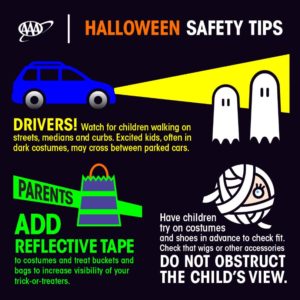
A “AAA Foundation for Traffic Safety analysis of national pedestrian fatality data has shown Halloween night (between 4 p.m. and midnight) is the deadliest night of the year for pedestrians.”
Spooky.
“The National Highway Traffic Safety Administration reports that Halloween is consistently one of the top three days for pedestrian injuries and fatalities, and the Centers for Disease Control and Prevention estimates that children are four times more likely to be struck by a motor vehicle on Halloween than any other day of the year.”
Creepy.
And further, according to the CDC, “On average, children are more than twice as likely to be hit by a car and killed on Halloween than on any other day of the year. Children are at a greater risk of injury than adults because they are small, have trouble judging distances and speeds, and have little to no experience with traffic rules.”
Horrifying.
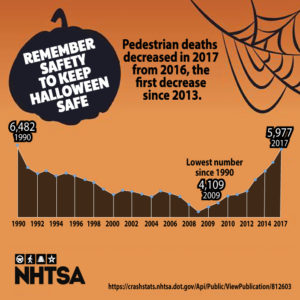
So, as a driver, what should you do? Here’s the CDC’s advice:
- Remove distractions. Put your phone in the glovebox or the back seat.
- Practice defensive driving. Be cautious and stay alert to reduce your risk of getting into a crash.
Enter and exit driveways and alleys carefully. - Watch your speed. Pay attention to the speed limit and drive slower when you are around pedestrians.
- Be prepared to stop. Trick-or-treaters may ignore crosswalks and traffic signals so stay alert. Do not pass a vehicle stopped at a crosswalk – they may be stopped for a pedestrian.
- Do not drive under the influence. Every 51 minutes, one person in the United States dies in a motor vehicle crash that involves an alcohol-impaired driver.
Good notes year-round, I’d say, not just Halloween.
Resources
Centers for Disease Control & Prevention: Halloween Rules of the Road
National Highway Transportation Safety Administration: Halloween Safety Tips
AAA Exchange: Halloween Safety
U.S Department of Transportation: Traffic Safety Marketing - Halloween
HAT TIP to Galion Inquirer: Halloween Safety Tips
Is Drunk Driving Still a Thing?
I don’t know about you, but I guess I sort of thought that drunk driving was a thing of the past.
I mean, with emergence of Uber and Lyft, why would anyone ever drive a car while intoxicated? It’s just so stupid and unnecessary.

Well, apparently it is still a thing.
I know this because I recently got a fundraising letter in the mail from Mothers Against Drunk Drivers (MADD). It turns out drunk driving is still the #1 cause of death on our roadways.

According to MADD, drunk driving “kills almost 11,000 people a year – one person every 48 minutes – and injures more that 315,000 others.” That’s 30 people. A. DAY.
MADD goes on to lament the lack of national attention on the issue. Sad, there are so many other issues that have pushed this one out of the limelight (mass shootings, for example; or vaping, for another).
The good news is that “drunk driving deaths are down by more than half from when [MADD] began” in 1980.
But that is little solace. Is any death or injury at the hands of a drunk driver okay? Yeah, no.
The National Highway Transportation Safety Administration has some solid videos as well as good info. Check it out.
The Law:
The AAA Digest of Motor Laws (my fave) indicates that "all 50 states and the District of Columbia prohibit the operation of a motor vehicle while under the influence of intoxicating beverages, with the illegal per se limit set at 0.08 percent blood alcohol concentration (.08 BAC). All 50 states and the District of Columbia set the legal drinking age at 21.
"Every state’s chemical test law has ‘‘an implied consent’’ provision providing that any person operating a motor vehicle on a public highway, who is suspected of driving while intoxicated, consents to a chemical test to determine if he or she is inebriated. Failure to submit or pass such a test may cause the driver’s license to be suspended or revoked regardless of any court action finding the person innocent of the charge.
"The most comprehensive resource on U.S. impaired driving laws is the National Highway Traffic Safety Administration’s Digest of Impaired Driving and Selected Beverage Control Laws. NHTSA’s Digest is updated annually."
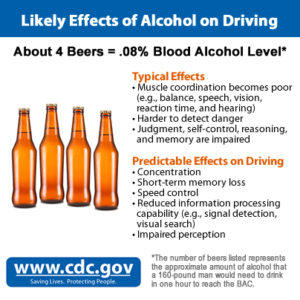
There are endless news articles and resources on this topic on the internet.
My final word on the matter? You are a total idiot, dummy and jackass if you drive drunk. It is exceedingly selfish. Just get yourself a darn Uber, Lyft, taxi or designated driver.
It’s not that hard.
Resources:
Intoxalock: Top 10 States with the Worst DUI Problems
USA Today: Most Dangerous States for Drunk Driving (2016)
Foundation for Advancing Alcohol Responsibility
#MoveOver for Emergency Vehicles
I choose to believe that the majority of drivers don’t know what to do when an emergency vehicle is in their midst, lights flashing, sirens blaring. Why else would they stupidly just keep driving like nothing is happening?

Some people think they know what to do – get over – but they don’t always do it. And, what do you do if you can’t get over?
Let me help.
The Law: Dubbed “Move Over” laws, all 50 states now have them except for the District of Columbia. (What the heck is up with that, D.C.??)
I digress. Moving on…
A "move over" law requires motorists to move over and change lanes to give safe clearance to law enforcement officers, firefighters, ambulances, utility workers, and in some cases, tow-truck drivers. Officers will pull over drivers who do not change lanes or lower their speed when they pass them doing their job on the streets.

Under current law In Maryland, for example, drivers should move over for police cars, ambulances and tow trucks that are parked along or in roadways – by at least 3 feet. The law was recently expanded to include transportation, service and utility vehicles, as well as waste and recycling trucks that have their lights flashing. If drivers cannot safely move over, the law requires them to slow down to a safer speed.
“Move Over, America” is a public awareness campaign to protect emergency personnel along the nation’s roadsides.
According to their web site, it “is a partnership originally founded in 2007 by the National Safety Commission, the National Sheriffs' Association and the National Association of Police Organizations. The partnership has also received the full support of the American Association of State Troopers. The campaign is the first nationally coordinated effort to educate Americans about "Move Over" laws and how they help protect the law enforcement officers who risk their lives protecting the public."
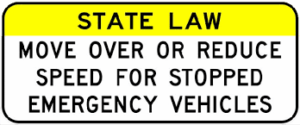
The Pew Charitable Trusts says, “Despite the laws, safety experts say many drivers remain ignorant of [move over laws] and that states need to do a better job of educating motorists about what’s at stake.”
Yes, it’s a pain when an emergency vehicle is approaching – it slows you down and prevents you from getting to your destination as quickly as you want.
But I always think to myself: ‘What if it was a member of my family in that ambulance?’ or ‘what if that firetruck is on the way to my house?’ I’d want them to get to their destination as fast as they could. Wouldn't you?
Special note to jerks: You know who you are. When people do the right thing and pull over and then try to get back onto the roadway once the emergency vehicle has passed and you don’t let them back in…jerk move.
Resources:
The Pew Charitable Trusts: 'Move Over' Laws Aim to Save Lives on the Highways
AAA Digest of Motor Laws: Move Over Laws
Crossing the Line(s)
In life, people cross the line all the time. The roads are no different.
Most of us had to take drivers education. Yes?
So, one of the basic things we learn in drivers ed is what the different line colors and types mean.
“Highway markings, used alone or to supplement other traffic control devices, provide important guidance and information to drivers without requiring them to divert their attention from the roadway. You should recognize all of the pavement markings and understand what they mean.”
– Your Driver’s Manual
On the roads, however, few people seem to understand them.
Perplexing.
So, let’s review.
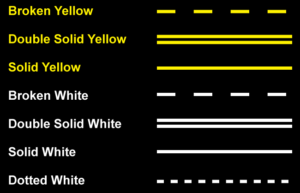
BROKEN WHITE LINE:
You may change lanes IF it is safe to do so.
SOLID WHITE LINE:
You are required to STAY within the lane; also marks the shoulder of the roadway.
YELLOW LINES:
- These mark the center of a two-way road used for two-way traffic.
- You may pass on a two-way road IF the yellow centerline is BROKEN.
- When a solid and a broken yellow line are together, you must NOT pass if you are driving next to the solid line.
- Two solid yellow lines mean NO passing. Never drive to the left of these lines.
Driving 101, right? Apparently not.

Let me re-emphasize a couple of points from above for you.
DO NOT CROSS a SOLID white line.
DO NOT CROSS two SOLID yellow lines.
Capiche?
This is not rocket science people. It is responsible and safe driving.
Resources:
Driversed.com: Signs, Signals & Markings
DriversPrep.com: Pavement Markings & What They Mean
Granny, Get Out My Way!
You may have read about Britain’s 97-year-old Prince Philip’s recent car accident.

The incident got international headlines, rightly so, and once again begged the question: when are you too old to drive?
In 2017, people 65 and older made up 18% of all traffic fatalities. And, some studies claim drivers over the age of 75 are just as dangerous as teenagers on the road.
Now, my folks just celebrated their 55th wedding anniversary (woot! Go mom and dad!). And, while they are a couple of decades younger than the prince, they would readily admit they are no spring chickens! But they both have a car and drive regularly.

Mom complains that dad doesn’t go the speed limit and is too cautious. Dad complains that mom is always yelling at him and distracting his driving.

I posed two questions to them both:
Would you be in favor of having to take a driving test again?
And, would you be in favor of a law that required you to turn in your keys at a certain age?
Their responses?
Mom: No and no.
Dad: Yes, but only after 85. And, would depend on the age.
Dad goes on to point out that his driving is “superb” and he claims he goes the speed limit “most of the time.” Mom would beg to differ.
Anyhoooooooo….
I bring all this up because I was behind an – ahem – “elderly” couple the other day and was a tad annoyed at how slow they were driving. But then I did what I typically do when I encounter this:
I ask myself, ‘what if it was my mom or dad?’
I can unequivocally say I would be a lot more patient. (I might still roll my eyes though.)

There’s no shortage of articles or research on this subject. There’s a lot to consider, and, in most cases, it probably depends on the individual.
The reality is, I don’t think there’s a one-size-fits-all answer to this.
There are lots of factors to consider: a loss of independence and safety concerns just to name two.
Agingcare.com offers up 20 warning signs that an elderly driver is no longer safe behind the wheel and the National Highway Transportation Safety Administration provides a list of questions that might be helpful if you think you need to have a conversation with an older driver about their driving.
I’ll also say, in my opinion, Lyft and Uber give older drivers a very solid transportation option. It really changes the game like never before having become so commonplace.
“We believe every senior should have access to great transportation options. We’re working to make it happen.”
Lyft also hasn’t ignored seniors and addresses the issue in their blog.
At the end of the day, I go back to my regular beliefs, regardless of how old you are. If you are going to drive:
- Drive with purpose.
- Driver with focus.
- Know where you are going.
- Pay attention to the road.
- Obey the laws.
If you do all those things, chances are, I’ll be cool with you on the road.
P.S. Dad, GET OUT OF THE LEFT LANE!
Resources:
The Elderly and Driving: When Is It Time to Hit the Brakes? (New York Times)
20 Warning Signs That an Elderly Driver is No Longer Safe Behind the Wheel (Agingcare.com)
National Institute on Aging: Older Drivers
NHTSA: Older Drivers
NHTSA CrashStats for Older Drivers
Uber: Independence for Older Adults
Lyft: New Solutions to Keep Seniors Moving

